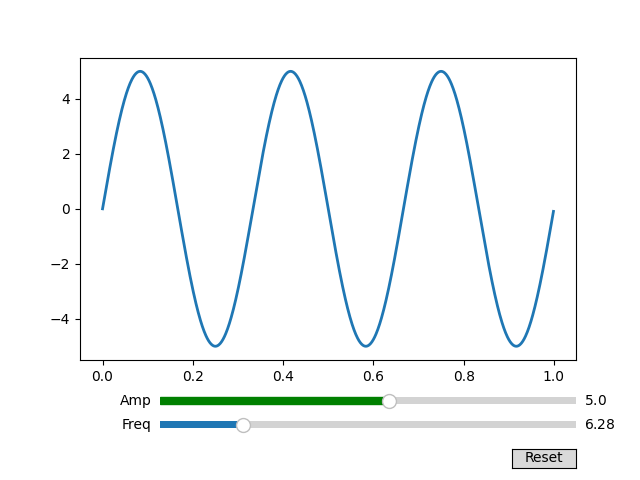笔记
单击此处 下载完整的示例代码
将滑块捕捉到离散值#
您可以使用参数将滑块值捕捉到离散值valstep。
在此示例中,Freq 滑块被限制为 pi 的倍数,而 Amp 滑块使用数组作为valstep参数以更密集地对其范围的第一部分进行采样。
有关使用 a控制单个浮点数的示例,请参见Slider 。Slider
有关使用 a定义值范围的示例,请参阅使用 RangeSlider 对图像进行阈值处理。RangeSlider
import numpy as np
import matplotlib.pyplot as plt
from matplotlib.widgets import Slider, Button
t = np.arange(0.0, 1.0, 0.001)
a0 = 5
f0 = 3
s = a0 * np.sin(2 * np.pi * f0 * t)
fig, ax = plt.subplots()
fig.subplots_adjust(bottom=0.25)
l, = ax.plot(t, s, lw=2)
ax_freq = fig.add_axes([0.25, 0.1, 0.65, 0.03])
ax_amp = fig.add_axes([0.25, 0.15, 0.65, 0.03])
# define the values to use for snapping
allowed_amplitudes = np.concatenate([np.linspace(.1, 5, 100), [6, 7, 8, 9]])
# create the sliders
samp = Slider(
ax_amp, "Amp", 0.1, 9.0,
valinit=a0, valstep=allowed_amplitudes,
color="green"
)
sfreq = Slider(
ax_freq, "Freq", 0, 10*np.pi,
valinit=2*np.pi, valstep=np.pi,
initcolor='none' # Remove the line marking the valinit position.
)
def update(val):
amp = samp.val
freq = sfreq.val
l.set_ydata(amp*np.sin(2*np.pi*freq*t))
fig.canvas.draw_idle()
sfreq.on_changed(update)
samp.on_changed(update)
ax_reset = fig.add_axes([0.8, 0.025, 0.1, 0.04])
button = Button(ax_reset, 'Reset', hovercolor='0.975')
def reset(event):
sfreq.reset()
samp.reset()
button.on_clicked(reset)
plt.show()
